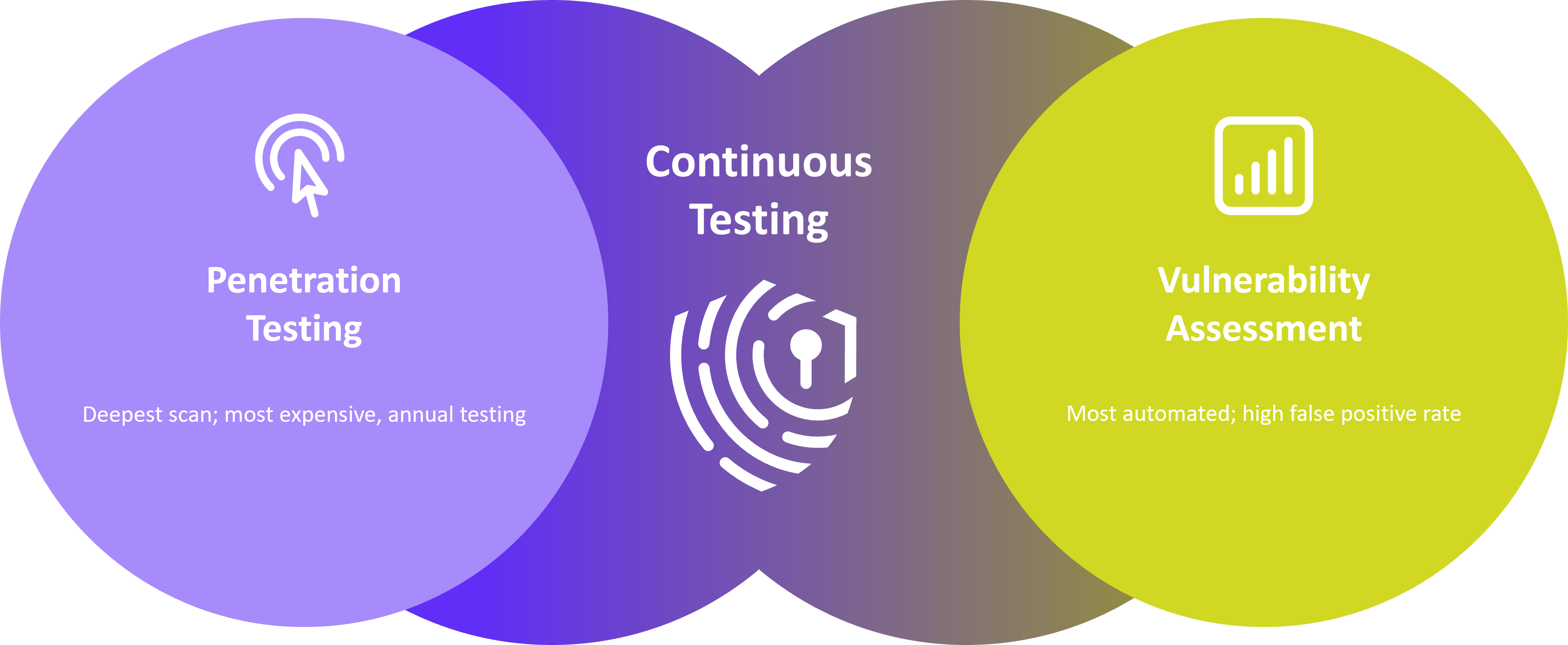Why Your AppSec Strategy Needs Continuous Testing
If you’re running a business with any kind of online presence, you’re probably already familiar with penetration testing and vulnerability assessments. While both do assist your application security (AppSec) team in identifying system weaknesses before attackers can exploit them, they also fall short in adapting to today’s application development practices. Modern development typically occurs over two-week “sprints” before new code is pushed to production. It takes only about 15 minutes after a new service or application goes live for an attacker to begin probing the environment. With point-in-time penetration testing performed only once a year, it could take just a couple of months for new vulnerabilities to be introduced. Vulnerability assessments on the other hand, are automated but require tuning and are most effective at testing individual components, not applications as a whole. They also tend to cause “alert fatigue” with their high false-positive rate.
For this reason, we want to introduce a third choice. Something that captures the best of both worlds plus some extra benefits: continuous testing.
What is Continuous Security Testing?
Continuous security testing is the ongoing process of evaluating your application for security vulnerabilities. It combines automated assessments with manual testing to provide comprehensive coverage and depth. The best part is that continuous security testing is designed to keep up with rapid application development cycles and frequent deployments.
At GlitchSecure, our continuous testing service integrates a variety of commercial and custom tools to identify vulnerabilities and correlate their results to capture the full scope of your application. We then follow this up with a manual review to verify findings and eliminate false positives. We like to be proof-positive, which means that we only report on things that our assessment team can actively exploit. This approach allows us to provide your team with actionable insights and clear guidance on where attackers might be trying to get in.
What Continuous Security Testing can do for You
Continuous security testing combines the benefits of penetration testing and vulnerability assessments, along with some additional advantages. Let’s dive into what those extras are:
-
Ongoing Visibility: Unlike annual penetration testing, continuous security testing provides ongoing visibility into your environment. This enables you to identify and address vulnerabilities as they arise, rather than waiting for the next annual test. This ongoing visibility allows your team to be proactive, rather than reactive, in detecting and remediating issues.
-
Reduced False-positives: Continuous security testing tools are tuned to your specific application instead of applying a generalised, “one-size-fits-all” approach. By combining automated tools with manual review, continuous security testing significantly reduces the noise of false positives that often plague vulnerability assessments.
-
Comprehensive Coverage: Continuous security testing offers broader coverage of scenarios and attack vectors compared to point-in-time assessments, giving you a more complete picture of your security posture. On top of that, the dynamic nature of continuous security testing allows it to adapt to nearly any environment. This means that as your systems or environment change, your testing evolves with them.
-
Cost-Effectiveness: By leveraging a managed continuous security testing solution, you gain the benefits of multiple commercial application security tools at a fraction of the cost. Additionally, automating the bulk of repetitive testing activities means that continuous security testing can be more cost-effective in the long run, while catching vulnerabilities early reduces the risk of costly breaches.
-
Ease of Use: What our customers appreciate the most when leveraging our continuous security testing solution is the ease of use. Many of them had already purchased a tool for internal use but quickly discovered how challenging it can be to set up properly. Initial configurations, scan frequency, and finding verification often required a full-time engineer just to manage the system. With our out-of-the-box approach, we handle that for you. This way, you receive all the benefits and insights without losing valuable resources in the process.

For our solution, we found ways to integrate well-known tools like Acunetix, Burp Enterprise, OWASP ZAP, Nuclei, and Nessus. If you’ve worked with any of these tools before, you know how much the results can vary from tool to tool and environment to environment. By diligently combining these systems, we’ve developed a service that not only delivers more results than any single tool on its own but also better identifies real, exploitable vulnerabilities.
How Continuous Security Testing Fits into Your Security Strategy
To understand how continuous security testing fits into your broader AppSec strategy, think of it like going to the dentist: Your annual pentest is akin to visiting the dentist’s office every 6-12 months. During that time, the dentist provides a thorough cleaning to keep your teeth happy and healthy. However, you still need to brush and floss daily, and that’s where continuous security testing comes in.
Use continuous security testing and penetration testing together to apply a layered approach. This combination provides a more comprehensive risk assessment, balancing frequent, automated checks with in-depth, manual analysis.
Taking the Next Step
By incorporating continuous security testing into your AppSec strategy, you can keep pace with rapid development cycles, catch vulnerabilities early, and maintain a robust security posture. At GlitchSecure, we’ve seen firsthand how continuous security testing can transform an organisation’s security approach. It’s not just about finding vulnerabilities; it’s about building a security-first culture that can adapt to emerging threats.
Ready to take your security to the next level? Let’s chat about how we can tailor a continuous security testing strategy to your specific needs.


